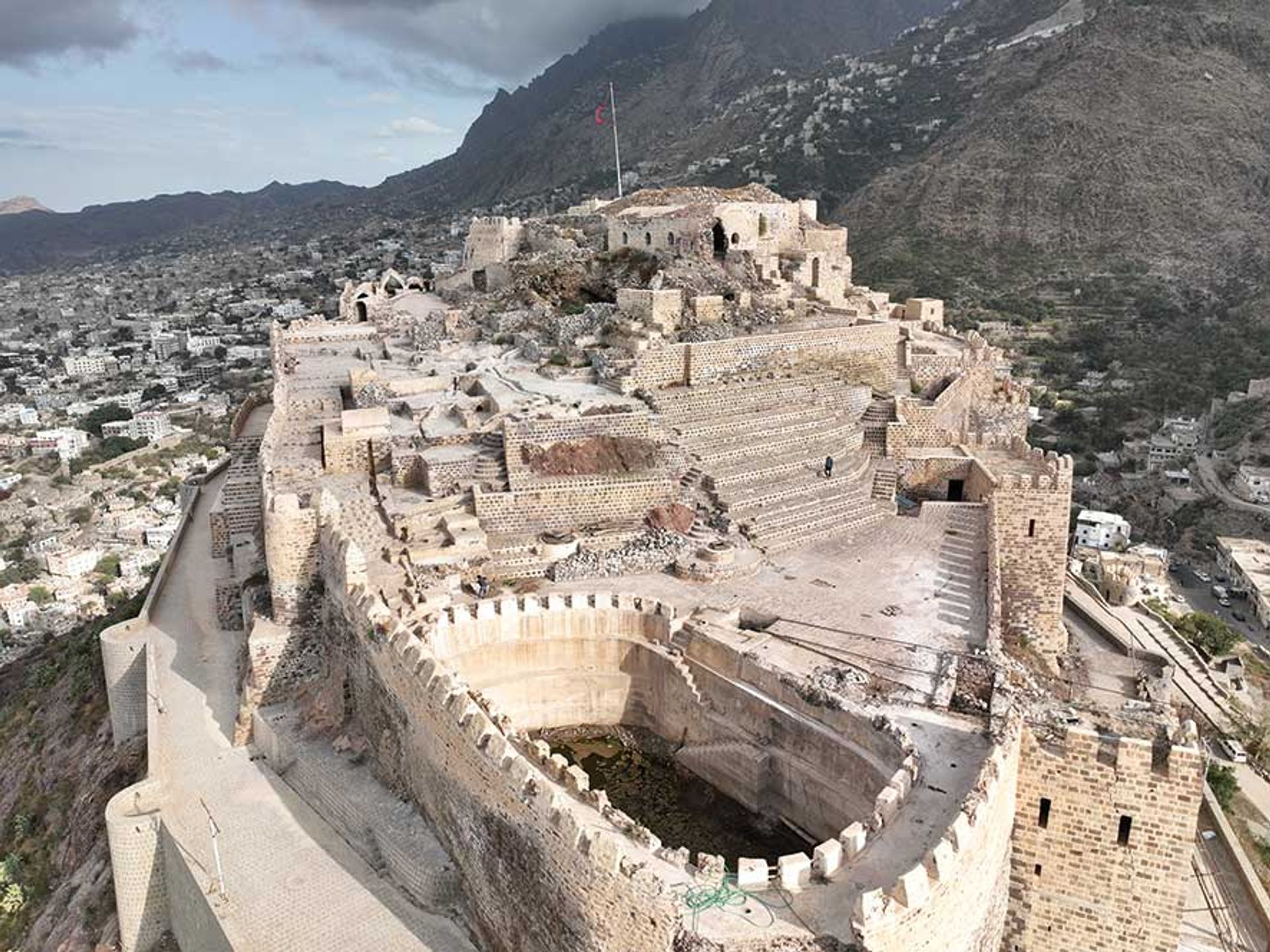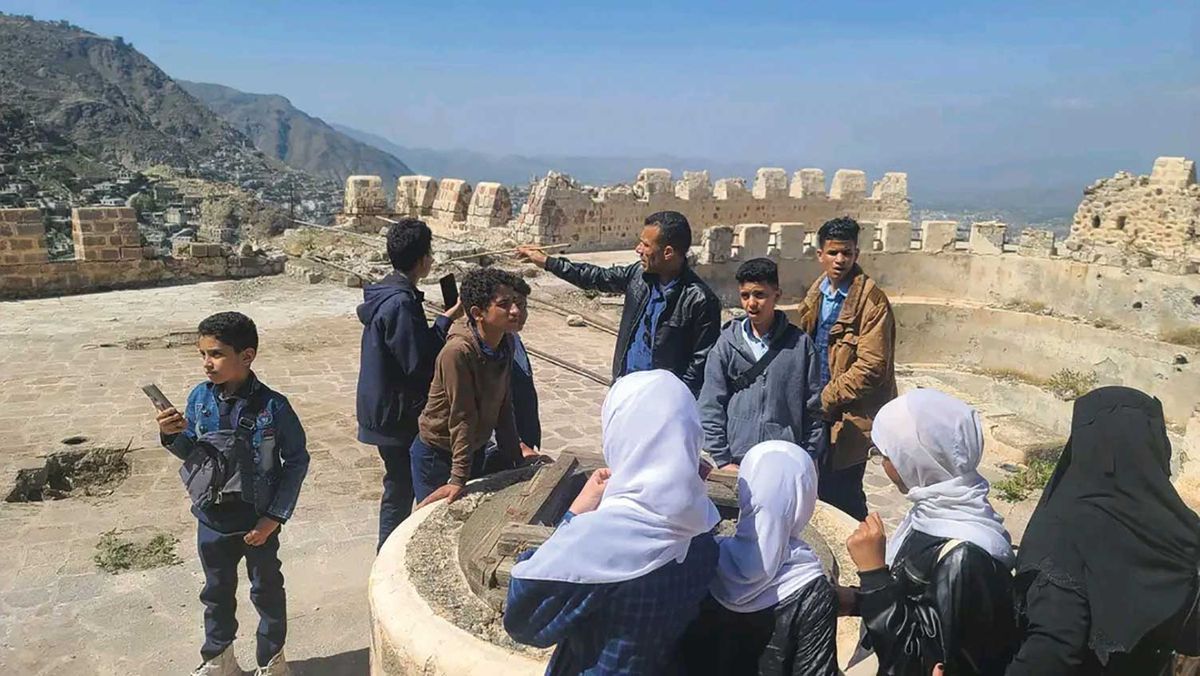An ancient castle in Yemen that was severely damaged in the country’s ongoing war has partially reopened following emergency repairs—a rare ray of hope in a country whose rich cultural heritage is in a desperate state.
At the end of April, the Spanish NGO Heritage for Peace completed emergency restoration work on Al Qahira Castle in Taiz, south-west Yemen, after airstrikes by the Saudi-led coalition in 2015 left the fortress unsafe. Rubble had collapsed into the neighbourhoods below the structure, a situation worsened by lack of maintenance and heavy rains. According to Isber Sabrine, the president of Heritage for Peace, falling debris also killed a person.
Believed to date from the 11th century, the castle overlooks Taiz from rocky highlands about 1,500m above sea level. Pre-Islamic archaeological finds, such as pottery statues offered to temple gods and evidence of a temple uncovered during excavations in the late 20th and early 21st centuries, suggest its origins may be older. The fort has played a key role throughout Yemen’s history and was used by various ruling dynasties over the centuries.
Struck by the city’s dire poverty, Sabrine says the project, supported by the University of the West of England, Bristol and funded by the Swiss-based foundation Aliph, brought much-needed humanitarian aid in the form of employment and local contracts.
“The castle is very important in the history of Taiz and is one of the main attractions in Yemen,” Sabrine tells The Art Newspaper. “Every person I met in Taiz shared a memory about the castle.” He says local people appreciate being able to visit it again—albeit currently only with supervision due to safety concerns—especially in view of a lack of shared social spaces because of the country’s wretched economic situation.
The most recent conflict began in late 2014, when the Ansar Allah group, also known as the Houthis, took over the north and west of the country, including the Yemeni capital, Sana’a. Alarmed by the rise of a group it viewed as an Iranian proxy, Saudi Arabia launched a military campaign in 2015, joined by other Sunni states including the United Arab Emirates (UAE) and backed by the US, to reinstall President Abd-Rabbu Mansour Hadi’s government. Hadi resigned in 2022 after losing the confidence of the allied governments and handed power to a newly formed Saudi- and UAE-backed Presidential Leadership Council (PLC). Today, the country remains divided and is ruled by different factions.
Immense human cost
The war’s human cost has been immense. The United Nations estimates that 24.1 million people—nearly 80% of the population—need humanitarian aid. Between 2015 and 2022, 377,000 people were killed, 60% indirectly from conflict-related issues such as hunger, lack of healthcare and unsafe water. Much of the country’s heritage has also been damaged or destroyed.
Yemen is home to one of the oldest civilisations in the Middle East. Its history encompasses large empires, such as the Minaean, the Sabaean (the biblical land of Sheba), the Ḥimyarite and the Sasanian dynasty of Persia from around 1,200 BC until Islam arrived in the seventh century. By the 15th century the Ottomans controlled parts of Yemen until their collapse in 1918, while south of Yemen fell under British rule in 1839 until 1967. With the British departure, the USSR established diplomatic relations with southern Yemen and gained influence in the area. Yemen as we know it was formed in 1990 with the unification of the US and Saudi-backed Yemeni Arab Republic in the north, and the Soviet-backed People’s Democratic Republic of Yemen in the south.
A 2018 report by Mwatana, a Yemeni organisation that records human rights violations, documented at least 34 sites that had been damaged or destroyed, including the Old City of Sana’a, a Unesco World Heritage Site, as well as museums, archaeological sites, citadels and religious sites. “Violating these heritage sites means violating international law,” a Mwatana spokesperson says.
In Hadhramaut, Yemen’s largest governorate, several conservation and restoration projects have taken place, says Riyadh Bakarmom, the general manager of Hadhramaut General Organisation of Antiquities and Museums. However, his organisation’s budget has been slashed, he says, leaving it almost entirely reliant on private donors and sporadic international support.
“Unfortunately, we are now struggling to protect and keep what we already gained and not lose it again—to keep our office working, keep the museum open, keep local events in the museum,” Bakarmom says.
He says archaeological sites such as the ancient historical settlement of Ribun are at risk from ongoing urban expansion and illegal excavations. Even so, Bakarmom says Hadhramaut is better off than the rest of Yemen because direct conflict ended in the area in 2016.
Yemen boasts one natural and four cultural Unesco World Heritage Sites. In 2015, airstrikes by the Saudi-led coalition on the Old City of Sana’a drew strong condemnation from Unesco. Sana’a has been inhabited continuously for over 2,500 years and is home to 103 mosques, 14 hammams and over 6,000 houses, all built before the 11th century. Although Unesco has been working to restore the damage in Sana’a and other affected areas, it says more support is needed.
“Despite ongoing efforts by Unesco and other local partners in the country, the needs in the field of culture remain very high on many fronts, requiring large interventions,” a Unesco spokesperson says. “The Old City of Sana’a, for instance, requires massive intervention to replace the sewerage and water network of the city and the rehabilitation of around 2000 buildings.”
Other heritage sites face similar challenges, Unesco says, and local authorities in many areas have “virtually no capacity” to safeguard them.
“Unesco favours engaging donors to fund the safeguarding of Yemen’s unique cultural heritage, going beyond the existing initiatives with a focus on improving livelihoods,” the spokesperson says.

The castle is perched on an outcrop above the city
Courtesy Heritage for Peace
Unesco launched a €12m project between 2018 and 2022, focused on four historic cities: Sana’a, Shibam, Zabid and Aden. The initiative rehabilitated 508 historic residential buildings and created employment for 6,236 people.
Following its success, a four-year, EU-funded €20m project began in 2022, aiming to employ 8,000 people in restoring heritage buildings and support 30 cultural organisations, as well as small and medium-sized enterprises in the field of culture. Unesco is also rehabilitating Seiyun Palace, which serves as a museum. Considered to be the largest mudbrick building in the world, its condition is poor after exposure to torrential rain and neglect.
One of the primary challenges facing experts in identifying exactly which sites have been impacted stems from the absence of a comprehensive record of the country’s historic sites. “If we're talking about the current state of heritage in Yemen and the impact of the war, it's often so difficult to talk about,” says Michael Fradley, a research associate at endangered archaeology of North Africa and the Middle East (EAMENA) project at the University of Oxford. “They have never really been well recorded or not recorded at all,” he says.
The political instability and the mountainous nature of the country have been the main contributors to this gap, Fradley explains. In response to the growing threats to archaeological sites, in 2015 EAMENA began the task of identifying and recording sites remotely using tools such as satellite imagery. The project, which is led by the University of Oxford in collaboration with the Universities of Durham and Leicester, has identified sites on an unprecedented scale, recording over 45,000 sites so far, many of which have not been recorded previously, Fradley notes. “This is still not full coverage of the country and there are still many more sites to add to our system,” Fradley says. Despite these efforts, verifying all identified sites on the ground remains a near impossible task due to the current unstable conditions.
Meanwhile, Sabrine is seeking funding for the next phase of Al Qahira’s restoration. In May its main entrance, already severely damaged, collapsed—largely due to insufficient maintenance and budgetary restraints.
“Culture is a basic human right,” he says. “It is very important to give life to this place and create a better life for the people of the city.”


